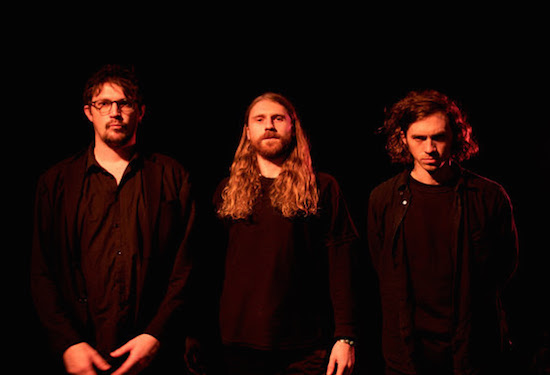Stoic is the brand new album from noise rock trio Ghold, with its release later this week marking the launch of a new label from London record shop Crypt of the Wizard.
Above, you can stream the new album in full exclusively ahead of its release on November 3. The album itself was recorded at Leeds Unitarian Chapel in March 2017, meaning that the 17th century building’s acoustic properties heavily influenced the resulting recordings. The band also opted to strip back their set-up for this record, only taking instruments that they felt were absolutely necessary into the recording.
The record shop responsible for the album’s release opened in March of this year, and has been quickly gathering attention as a haven for fans of music of a heavier disposition in London. They have a number of records planned to follow this inaugural release.
Whilst you enjoy the album, you can read on below for a quick catch-up with the band about Stoic and Crypt of the Wizard. You can pre-order the album ahead of its release here.
Stoic is the first release on Crypt of the Wizard’s own label. How did the connection come about between yourselves and the record shop?
We’ve known Charlie [Woolley, shop manager] for a few years as a friend, and Marcus [Mustafa, shop owner] more recently (Oli performing duties as his cat-sitter). Alex and Charlie were friends from the art world from years back, and this led to a collaborative live spoken-word/heavy psych performance between Ghold and Charlie at Plymouth Arts Centre back in 2015. Since then we have hung out lots, been to lots of live shows together, got drunk together, been on tour together and ripped the piss out of each other. After the shop opened, The Wizards wanted to start a label and release something of ours. It came at a perfect time for us, and so a blood-oath was taken, the ball of aural lead was rolled and the record was pressed!
Would you say that Stoic marks a change in direction in some way from previous LPs from yourselves?
Yes, there’s a definite bending of direction with STOIC, but anyone who’s familiar with the other records should be able to hear and understand the progression. It’s not so different as to intentionally confuse or disorientate people who like OF RUIN or PYR. We’ve drawn out sonic elements that were always there from our earliest days – ‘chanted’ vocals, ambient textures, heavy riffs, swirling psychedelia, twisting compositions.
This time however, we’ve tried to put these elements across more concisely, with less of the roughneck riff-chopping style of before. Vocals, lyrics and their subtle transformations play a larger part this time around, and we’ve allowed a certain amount of languidness to creep in to the pot in terms of riff. Songs can sit back on their big fat haunches and allow themselves to steep in their own pungent juices with STOIC, a miserable or uplifting swirl of noise certain to brighten/darken up your day or night. The manifesto of Go Home Or Leave Deaf remains!
The album was recorded in Leeds Unitarian Chapel. To what extent did the setting and the building’s acoustics influence or shape the end product?
The space definitely suited the recording of this album down to the ground, and perhaps (subconsciously at least) this affected how we wrote the songs. Again, that sense of languidness with the riffs, and the more minimal compositions allowed us and Thom Goodall (Mirror Man Recordings) to go nuts with mic placement. We really wanted to explore the space and take advantage of the huge stone arches and pillars and wood-panelled walls to let the songs breathe through big, natural reverb. We used lots of ambient mics, and everything was recorded live.
We set up multiple drum kits in triangular formation around the pews for a ‘call and response’ piece (Faeder Ure) (excellently conducted by Alex Race), we ran in circles around the altar ringing bells with microphones placed high above, we opened a grand piano and played the strings inside with mallets, we positioned mics at the farthest corners of the church when we recorded vocals – and these are the most prominent in the mix. We stayed late into the night and observed the sonic weirdness of a busy weekend in a big city from the inside of this huge stone heart plonked right in the middle. You can hear the Chapel in STOIC.
You opted to strip back the tools used to produce the album and only bring in instruments that were absolutely necessary for its production and recording. Why did you decide to do that for this record?
The songs were already pretty much fully-fleshed out from a live perspective, and we realised we didn’t need a huge amount of overdubs or crazy instrumentation happening on the recording. We’d hammered the whole album out on the road in Spain, Portugal and France for two weeks prior, so when it came to recording we were tight, focussed and knew what was on the cards when we came to record. We were skint, left management, and were personally on our arse, but musically ‘with it’ and knew we had to act with purpose.
Our good friend Tom Goodall (Mirror Man Recordings, phenomenal bass player of Leeds-based band Cattle) had access to the church – load in, load out, move in the desk, set up, set down, worship, repeat. The album is a live performance, delivered via post-production past the hours of church happenings. Previously on our records we’d gone hard on the overdubs, but with STOIC only the last track, ‘Skhul V’, has noisy guitar overdubs. Everything else was made in-house, apart from ‘Blue Robe’ which began life as a Cubase 5 loop, digested through our internal passages, mixing with bile and phlegm until it developed a physical body.


